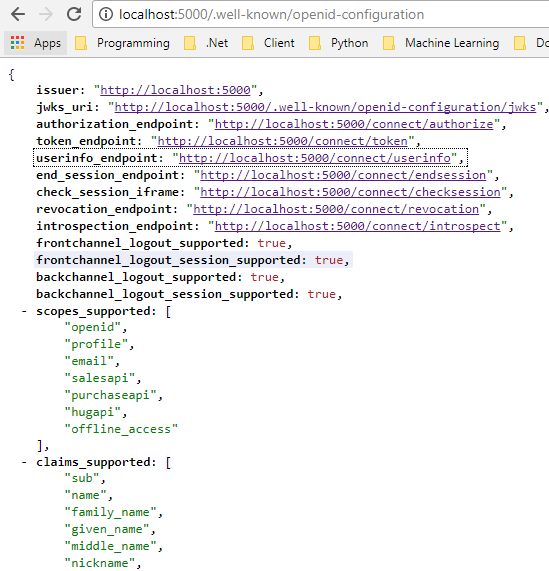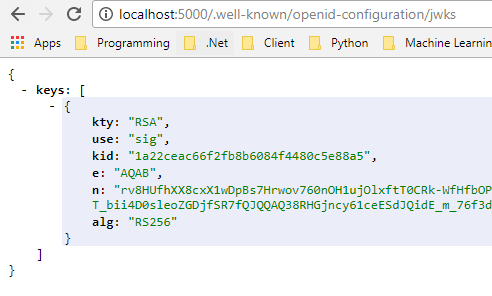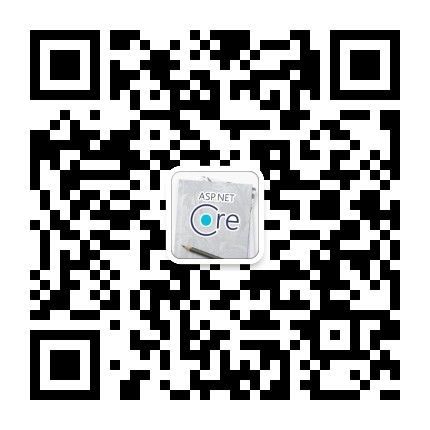[新添加] 本文对应的源码 (多个flow, clients, 调用python api): https://github.com/solenovex/Identity-Server-4-Python-Hug-Api-Jwks
目前正在使用asp.net core 2.0 (主要是web api)做一个项目, 其中一部分功能需要使用js客户端调用python的pandas, 所以需要建立一个python 的 rest api, 我暂时选用了hug, 官网在这: http://www.hug.rest/.
目前项目使用的是identity server 4, 还有一些web api和js client.
项目的早期后台源码: https://github.com/solenovex/asp.net-core-2.0-web-api-boilerplate
下面开始配置identity server 4, 我使用的是windows.
添加ApiResource:
在 authorization server项目中的配置文件添加红色部分, 这部分就是python hug 的 api:
public static IEnumerable<ApiResource> GetApiResources() { return new List<ApiResource> { new ApiResource(SalesApiSettings.ApiName, SalesApiSettings.ApiDisplayName) { UserClaims = { JwtClaimTypes.Name, JwtClaimTypes.PreferredUserName, JwtClaimTypes.Email } }, new ApiResource("purchaseapi", "采购和原料库API") { UserClaims = { JwtClaimTypes.Name, JwtClaimTypes.PreferredUserName, JwtClaimTypes.Email } }, new ApiResource("hugapi", "Hug API") { UserClaims = { JwtClaimTypes.Name, JwtClaimTypes.PreferredUserName, JwtClaimTypes.Email } } }; }
修改js Client的配置:
// Sales JavaScript Client new Client { ClientId = SalesApiSettings.ClientId, ClientName = SalesApiSettings.ClientName, AllowedGrantTypes = GrantTypes.Implicit, AllowAccessTokensViaBrowser = true, AccessTokenLifetime = 60 * 10, AllowOfflineAccess = true, RedirectUris = { $"{Startup.Configuration["MLH:SalesApi:ClientBase"]}/login-callback", $"{Startup.Configuration["MLH:SalesApi:ClientBase"]}/silent-renew.html" }, PostLogoutRedirectUris = { Startup.Configuration["MLH:SalesApi:ClientBase"] }, AllowedCorsOrigins = { Startup.Configuration["MLH:SalesApi:ClientBase"] }, AlwaysIncludeUserClaimsInIdToken = true, AllowedScopes = { IdentityServerConstants.StandardScopes.OpenId, IdentityServerConstants.StandardScopes.Profile, IdentityServerConstants.StandardScopes.Email, SalesApiSettings.ApiName, "hugapi" } }
修改js客户端的oidc client配置选项:
添加 hugapi, 与authorization server配置对应.
{ authority: 'http://localhost:5000', client_id: 'sales', redirect_uri: 'http://localhost:4200/login-callback', response_type: 'id_token token', scope: 'openid profile salesapi hugapi email', post_logout_redirect_uri: 'http://localhost:4200', silent_redirect_uri: 'http://localhost:4200/silent-renew.html', automaticSilentRenew: true, accessTokenExpiringNotificationTime: 4, // silentRequestTimeout:10000, userStore: new WebStorageStateStore({ store: window.localStorage }) }
建立Python Hug api
(可选) 安装virtualenv:
pip install virtualenv
然后在某个地方建立一个目录:
mkdir hugapi && cd hugapi
建立虚拟环境:
virtualenv venv
激活虚拟环境:
venv\Scripts\activate
然后大约这样显示:

安装hug:
pip install hug
这时, 参考一下hug的文档. 然后建立一个简单的api. 建立文件main.py:
import hug @hug.get('/home') def root(): return 'Welcome home!'
运行:
hug -f main.py
结果好用:

然后还需要安装这些:
pip install cryptography pyjwt hug_middleware_cors
其中pyjwt是一个可以encode和decode JWT的库, 如果使用RS256算法的话, 还需要安装cryptography.
而hug_middleware_cors是hug的一个跨域访问中间件(因为js客户端和这个api不是在同一个域名下).
添加需要的引用:
import hug import jwt import json import urllib.request from jwt.algorithms import get_default_algorithms from hug_middleware_cors import CORSMiddleware
然后正确的做法是通过Authorization Server的discovery endpoint来找到jwks_uri,
identity server 4 的discovery endpoint的地址是:
http://localhost:5000/.well-known/openid-configuration, 里面能找到各种节点和信息:

但我还是直接写死这个jwks_uri吧:
response = urllib.request.urlopen('http://localhost:5000/.well-known/openid-configuration/jwks') still_json = json.dumps(json.loads(response.read())['keys'][0])
identity server 4的jwks_uri, 里面是public key, 它的结构是这样的:

而我使用jwt库, 的参数只能传入一个证书的json, 也可就是keys[0].
所以上面的最后一行代码显得有点.......
如果使用python-jose这个库会更简单一些, 但是在我windows电脑上总是安装失败, 所以还是凑合用pyjwt吧.
然后让hug api使用cors中间件:
api = hug.API(__name__) api.http.add_middleware(CORSMiddleware(api))
然后是hug的authentication部分:
def token_verify(token): token = token.replace('Bearer ', '') rsa = get_default_algorithms()['RS256'] cert = rsa.from_jwk(still_json) try: result = jwt.decode(token, cert, algorithms=['RS256'], audience='hugapi') print(result) return result except jwt.DecodeError: return False token_key_authentication = hug.authentication.token(token_verify)
通过rsa.from_jwk(json) 就会得到key (certificate), 然后通过jwt.decode方法可以把token进行验证并decode, 算法是RS256, 这个方法要求如果token里面包含了aud, 那么方法就需要要指定audience, 也就是hugapi.
最后修改api 方法, 加上验证:
@hug.get('/home', requires=token_key_authentication) def root(): return 'Welcome home!'
最后运行 hug api:
hug -f main.py
端口应该是8000.
运行js客户端,登陆, 并调用这个hug api http://localhost:8000/home:
(我的js客户端是angular5的, 这个没法开源, 公司财产, 不过配置oidc-client还是很简单的, 使用)

返回200, 内容是:

看一下hug的log:

token被正确验证并解析了. 所以可以进入root方法了.
其他的python api框架, 都是同样的道理.
[新添加] 本文对应的源码 (多个flow, clients, 调用python api): https://github.com/solenovex/Identity-Server-4-Python-Hug-Api-Jwks
可以使用这个例子自行搭建 https://github.com/IdentityServer/IdentityServer4.Samples/tree/release/Quickstarts/7_JavaScriptClient
官方还有一个nodejs api的例子: https://github.com/lyphtec/idsvr4-node-jwks
今日修改后的代码:
import json import hug import jwt import requests from jwt.algorithms import get_default_algorithms from hug_middleware_cors import CORSMiddleware api = hug.API(__name__) api.http.add_middleware(CORSMiddleware(api)) def token_verify(token): access_token = token.replace('Bearer ', '') token_header = jwt.get_unverified_header(access_token) res = requests.get( 'http://localhost:5000/.well-known/openid-configuration') jwk_uri = res.json()['jwks_uri'] res = requests.get(jwk_uri) jwk_keys = res.json() rsa = get_default_algorithms()['RS256'] key = json.dumps(jwk_keys['keys'][0]) public_key = rsa.from_jwk(key) try: result = jwt.decode(access_token, public_key, algorithms=[ token_header['alg']], audience='api1') return result except jwt.DecodeError: return False token_key_authentication = hug.authentication.token(token_verify) @hug.get('/identity', requires=token_key_authentication) def root(user: hug.directives.user): print(user) return user
我的博客即将搬运同步至腾讯云+社区,邀请大家一同入驻:https://cloud.tencent.com/developer/support-plan
下面是我的关于ASP.NET Core Web API相关技术的公众号--草根专栏:



